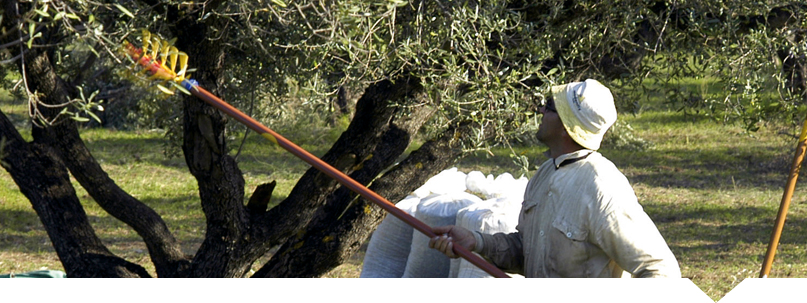Story of olive oil
The olive
The story of a good olive oil starts at the source, the olive tree. It likes a Mediterranean climate and can live hundreds of years.
The tree produces the most olives when it is between 7 and 35 years old. The weather, the amount of sun-hours and the quality of the soil are all influencing the growth
and eventually the taste of the olive oil. There are more than 85 different sorts of olives.
The olive tree blooms in springtime from April to June and has white blossoms. In June, the flowers grow into olives that get more and more fleshy. The olives eventually start to change in #160;

Health
At the same time, the earlier the olives are picked, the healthier the olive oil is. Olive oil contains a lot of monounsaturated fatty acids, which are also known as ‘good’ fats, that contribute to the reduction of cholesterol and a high level of vitamin E.
Olive oil is also known for the large amount of natural antioxidants that can combat free radicals in our body. The free radicals are aggressive substances that can damage cells and tissues in unfavorable cases. Antioxidants can help you counteract this damage and therefore prevent diseases like cancer and cardiovascular diseases in the long run.

Extra Virgin
Oil & Vinegar only sells olive oil from the first pressing. This is the highest quality of olive oil that is cold-pressed from the flesh of fresh olives. This oil is pressed with only mechanical means and is furthermore untreated. This so-called Extra Virgin Olive Oil (EVOO) has a maximal acidity level of 0,8%, the level of free fatty acids expressed in a percentage of fatty acids. The lower the acidity, the higher the quality of the olive oil. This fact in itself does not say anything about the taste of the olive oil. This is surely a very personal experience.
As with wine, a predicate of origin can be assigned to the EVOO by the Department of Agriculture from the country in origin. It provides a warranty for the region and the quality. This is better known as protected designation of origin (PDO).
Amongst other things, the term DOP (Italian), AOC (French) and DPO (Spanish) can be used. For the conservation of the scent and flavor we advise to particularly use our Extra Virgin Olive Oil cold or at room temperature. Filtered EVOO can also be used up to 180ºC for baking and roasting. Oil & Vinegar also offers an Extra Virgin Olive Oil that can be heated up to 210ºC. This oil is very suitable for baking, frying, stir-frying and deep-frying.
Harvest
When olives are picked earlier, this automatically means that less oil can be produced from the same amount of olives. Oil & Vinegar stands for the best quality. Therefore our olive farmers produce only the highest quality of extra virgin olive oil and will not wait with picking the olives, contrary to industrially produced olive oils.
De first olives are – depending on the country – harvested in September. Sometimes the olives are picked when they are green, and sometimes when they are black. Most of the harvesting happens between November and February. Green olives are picked early on in the season. For olive oil, a mix of unripe, half ripe and fully ripe olives is used.
Most olives are ‘raked’ off the trees by hand. In some olive groves, vibrating machines are used to shake the olives out of the trees. Nets and canvas on the ground are used to catch the fruits. This prevents the olives from being damaged and makes it easier for the farmers to collect the olives.
Harvested olives are processed within 72 hours to avoid oxidation and fermentation. A fair amount of our producers handle a harvesting process where there is a maximum of 10 hours time between the harvesting and the pressing. Of course this is very beneficial for the quality of the olive oil.
Every year, “Novello” olive oil is pressed from the first new olive harvest. This is for olives what Beaujolais Primeur is for Beaujolais wine. This extra virgin olive oil is unfiltered and is bottled right after pressing. This is the reason why the Novello has such a fresh, grassy taste that is typical for fresh olives.
The production process
In the past, olives were pressed into a thick olive mass between two (mostly granite) millstones within 3 days after harvesting. This thick mash was spread onto round, woven mats (scourtins) that were stacked on top of each other. These stacks of mats were then hydraulically pressed. The fluid from this pressing comes from a mixture of oil and bitter flavors dissolved in water. The water and the oil were separated by centrifugation (active) or by decanting (passive). Ultimately the oil was filtered. Nowadays, the olives are pressed according to a continuous system that combines al these steps in one process, which results in oil of better quality because of the reduced amount of oxidation during the process.
Five kilograms of olives will only produce 1 liter of olive oil. One olive tree grows an average of 15 to 50 kilograms of olives per year, or 3 to 10 liters of olive oil. Olive oil can be stored best in a cool, dry and dark place.

